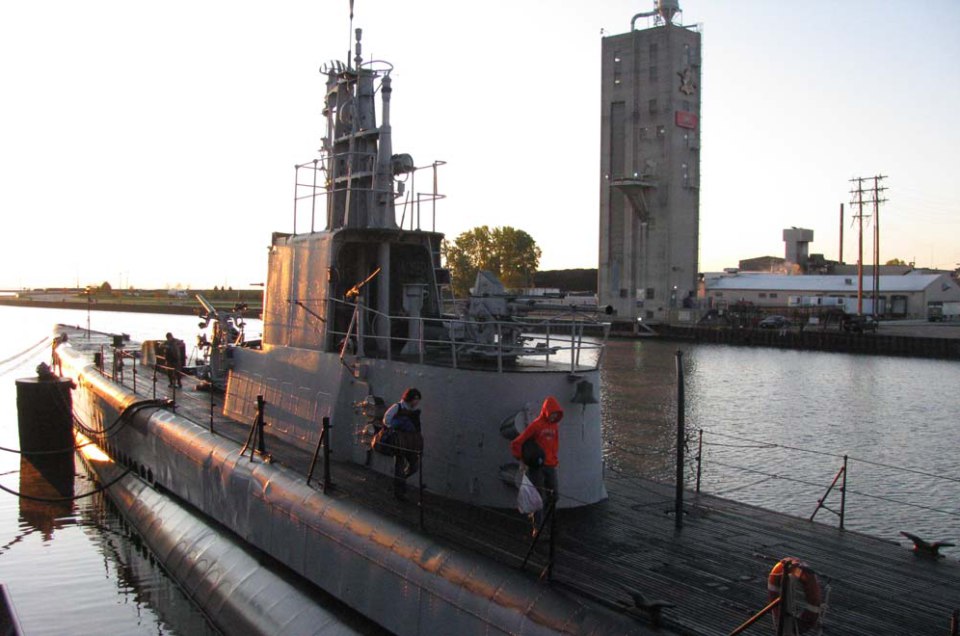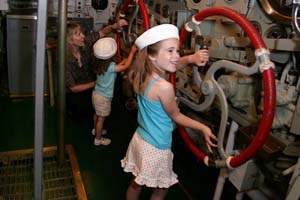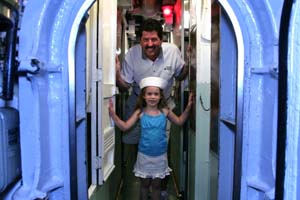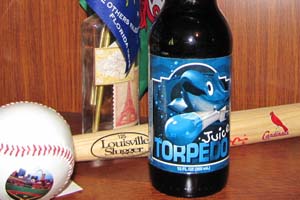Sitting on a shelf in my son’s bedroom, along with a collection of other family vacation souvenirs, is an unopened bottle of Torpedo Juice.
Torpedo Juice today is a root beer bottled in Green Bay, Wisconsin. We learned about its history and so much more when we visited the Wisconsin Maritime Museum in Manitowoc, a pleasant little community on Lake Michigan’s western shore.
This is the largest maritime museum on the Great Lakes and the focal point of the museum is a submarine – the U.S.S. Cobia – was built here in 1943, along with 28 other submarines that saw combat in World War II.
Now a National Historic Landmark, the Cobia was responsible for sinking 13 Japanese destroyers in the South Pacific.
At that time, the Cobia was home to 80 sailors working 12 hour shifts in 100-degree heat, not seeing the light of day or receiving any fresh air (or baths) for up to 60 days at a time.
Climbing down the narrow stairway and stepping gingerly over thresholds of the watertight doorways, I was already wondering about the wisdom of our decision to spend the night sleeping in this historic vessel.
My son, however, was swinging along like a monkey, running through the narrow pathways with the agility reflecting his age. I knew those brave sailors of WWII, not really that much older than my baby boy when they went to war, had to have been equally agile in these tight quarters. It was often a matter of life and death.
Fortunately, the Cobia is now air conditioned and heated, making our overnight accommodations somewhat more comfortable than it would have been in the 1940s. And we were fairly confident that Japanese destroyers would not be dropping depth chargers or firing torpedoes at us, so overall, we had nothing to complain about.
As we spread our sheets, blankets and pillows on our little bunks, my respect for those hardy veterans vaulted even higher. There were four bunks hanging via chains, one separated from the next by less about 24 inches. Other berths folded up against the wall and our son – he chose the bunk right on top of the torpedo.
None of the plumbing in the Cobia functions any longer, so restroom visits required us to climb back up out of the submarine and use a very modern and comfortable facility inside the museum. We ate our snacks in shifts in the tiny kitchen that was large enough to accommodate about 10 people at a time. I could not imagine transporting enough food and feeding 80 men in facilities this tiny.
Most nights, the Cobia is filled with Scout troops earning patches or school and church groups. Even though 80 sailors made their home in the submarine during the war, only 55 people at a time may now spend the night. One or two nights a month are devoted to families who are not affiliated with any group.
That’s what we were doing and soon were assigned duties: loading torpedoes, decoding messages, sounding alarms and preparing for battle. They called us pollywogs, a nickname seasoned sailors gave those on their first sea patrol.
And we learned about Torpedo Juice, a drink that submerged sailors created by combining fruit juices and the nonlethal liquid fuels that propelled torpedoes of the time period. Some submarine crews became legendary for the special mixes.
Finally it was lights out and sleeping, while not the best night I had, was not entirely impossible in such unusual conditions. The next morning, our duties included sweeping up and cleaning our bunks. We took ourselves out to breakfast and then returned to explore the museum in greater detail.
The little community of Manitowoc was the only inland port contracted to make submarines during the war, eventually sending 28 completed vessels into battle. The port was perfectly suited for sea trials and is widely recognized for keeping the U.S. Navy functioning in those first months after the attack on Pearl Harbor. Street names such as Kete, Peo and Rashee are the names of commissioned submarines built here more than 60 years ago.
The Wisconsin Maritime Museum also tells the story of boat building in Manitowoc, including the use of ice breakers and car ferries on Lake Michigan. Other exhibits allow kids to play with boats in various pools of water designed to replicate conditions at sea and the navigation challenges sailors encounter. One area allows kids to build their own model boats to take home with them.
Our son’s favorite souvenir, however, was a six pack of Torpedo Juice, one of the best selling items in the museum’s fun-filled and educational gift shop. And the bottle sitting in his room now is a reminder that mom’s decision to book this family getaway was a pretty darned good one.



